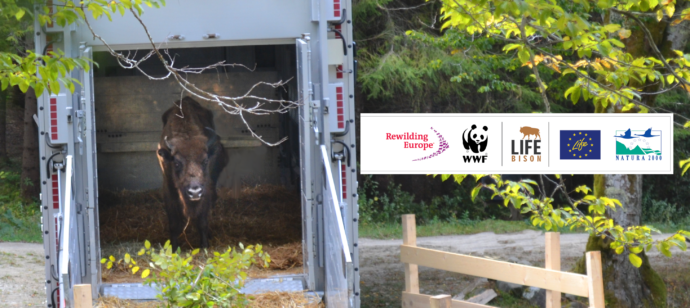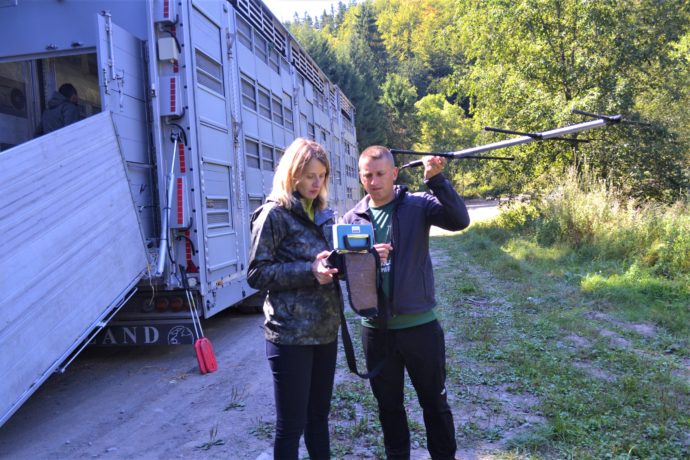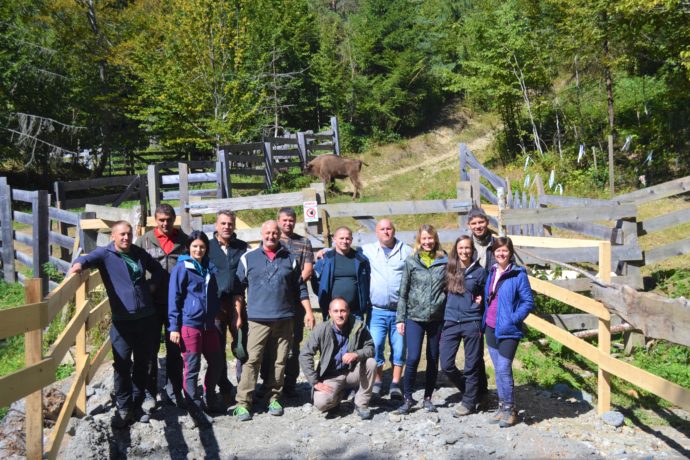Another sucessful bison transport in the Southern Carpathians
Another successful bison transport took place last week when 4 female bison arrived safely in the Țarcu Mountains, in the vicinity of Armeniș commune, where they will join more than 50 free-roaming bison in the Southern Carpathians.

Bison Transport in the Bison Hillock
WWF Romania
The animals come from two locations, three from the Donaumoos Bison Reservation and one from the Bison Breeding Centre in Hunedoara, from where they were carefully selected, based on genetics, age, and species management so as to have an increased chance of adapting and reproduction in their new environment. Xannika, a female bison from the Karlsruhe Zoo, Germany was also transported to the breeding centre, a 6000 square meter special enclosure, created at the Hunedoara Zoo in 2016 by WWF and Rewiling Europe as part of the Life-Bison project.

Xennika is released in the breeding centre created by WWF Romania and Rewilding Europe in collaboration with Hunedoara Zoo WWF ROMANIA
„Xannika is essential in ensuring the new generations have a diverse gene pool. Releasing bison from the breeding centre will reduce the stress resulting from relocating animals from thousands of miles away. Romarta, the female bison born in the breeding center two years ago, who now joined the group of 3 females from Domaumoos is a positive example of the success of this center.” Ciprian Hodor, Veterinarian
The females from the Bison Hillock in the Țarcu Mountains will remain under the close supervision of the rangers and the veterinarian for the period of acclimatization, and in a few months they will join the free bison.
“They traveled more than 1000 km and arrived in good condition. Now begins the process of acclimatisation in which we will ensure that they are healthy and prepared for the life in the wild. This whole process involves complex work and a very strong collaboration, thus the professionalism of the partners in Germany, of the transport company Hunland and the Hunedoara Zoo and especially the support of the local community that has been with us since the beginning of the project are extremely valuable. ” Marina Drugă, Project Manager Life-Bison.
In June, another 7 bison brought from Germany also arrived in the place now know as the Bison Hillock. There are now over 60 bison in both project areas, more specifically in the Armeniș area, Caraș-Severin county and in the vicinity of Densuș commune, Hunedoara county. These majestic creatures returned to the Southern Carpathians after 200 years of absence due to poaching and habitat loss.
If a few years ago they were rarer than the black rhinoceros, now, thanks to conservation efforts, the populations of European bison (Bison bonaus) throughout Europe are growing.
Record-breaking reintroduction
Once widespread across Europe, wild European bison were driven to extinction in the early twentieth century by hunting and habitat loss. Starting in 2014, the ongoing bison reintroduction programme by Rewilding Europe and WWF Romania is the largest ever attempted in the Southern Carpathians.
The first two bison releases took place in 2014 and 2015 in the Țarcu Mountains, close to the small town of Armeniș. In June 2016, a third bison release took place here as part of the European Commission-funded LIFE Bison project, with annual releases now ongoing. In 2018 another 23 bison were released into the wild, including 14 animals at a second rewilding site in the Poiana Ruscă Mountains.
The overall objective of the LIFE Bison project, which runs until December 2020, is to establish a wild bison population that is demographically and genetically viable in the Southern Carpathians. Subpopulations will be connected by corridors, enabling migration and genetic exchange.

Telemetry testing Alexandra Sallay-Mosoi, Technical Manager and Danu Hurduzeu, ranger
Nature, the key to community development in the Bison Hillock
Bison are the central piece of a rewilding vision in which nature becomes the key to community development of this region and a source of well-being for local communities. This is due to the continuous efforts invested in ecotourism, community development, education, research and technological innovation, for the benefit of nature and man alike.
Nature research and monitoring are key priorities, to measure the impact of bison on this diverse landscape and on biodiversity, to underpin conservation actions, to better understand and mitigate challenges such as human-wildlife conflicts.
On the local development side, the initiative encouraged the establishment, by the locals, of an association called AMZA (Măgura Zimbrilor Armeniș Association), which is the local partner in the organization of transports and releases of bison, in the relationship with the local authorities, in the development and the provision of services such as ecotourism (e.g. accommodation and meals, specialized guide) and local products.

Life-Bison team members rejoicing another successful transport
Close collaboration
Rewilding Europe and WWF Romania collaborate closely with local communities at both bison release sites, with the involvement of local entrepreneurs, forest managers, hunting associations and tour operators ensuring the bison reintroduction programme has the best possible outcome.
Want to know / experience more?
- Learn more about the LIFE Bison project
- Track reintroduced bison in the Southern Carpathians with the European Safari Company
- Visit the Rewilding Southern Carpathians Facebook page
Blog entries express the views and opinions of their authors, which might not always fully overlap with those of Rewilding Europe.